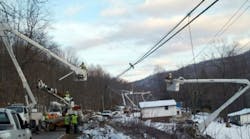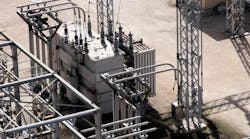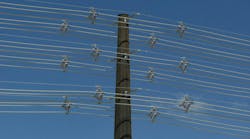Hurricane Sandy ranks as the most damaging event FirstEnergy has faced thus far. The storm affected more customers than Hurricane Irene combined with an October 2011 snowstorm, and more than twice as many customers as last summer's derecho (a straight-line windstorm associated with a fast-moving band of severe thunderstorms). In fact, FirstEnergy considered this storm along the same order as Hurricane Katrina's magnitude. By the time the winds died down and the floodwaters receded, Sandy had crossed every single state FirstEnergy serves and impacted nearly every service territory, ultimately disrupting service to more than 2.47 million FirstEnergy customers.
Hurricane-force winds and rains hammered FirstEnergy territories in New Jersey, Pennsylvania and parts of Maryland. FirstEnergy utilities in western Maryland and parts of West Virginia found themselves blanketed with heavy snowfall, upward of 2 ft (0.6 m) in some areas and facing winds in excess of 50 mph (80 kmph). In Ohio, FirstEnergy experienced high winds and rains along the Lake Erie shoreline.
Following is a breakdown of the customers who lost power due to Hurricane Sandy per FirstEnergy utility: 1.2 million JCP&L customers in New Jersey were affected, followed by 445,000 CEI/Ohio Edison customers in Ohio. In Pennsylvania, 440,000 Met-Ed, Penelec and West Penn Power customers lost power. Service disruptions also were experienced by 146,000 Potomac Edison customers in Maryland and 36,000 Mon Power customers in West Virginia.
FirstEnergy responded to the catastrophic destruction caused by Sandy with the largest mobilization of crews, equipment, material and support in the company's history. While the regional dispatch offices of FirstEnergy's utilities directed local restoration efforts, FirstEnergy's emergency operations center at its Akron, Ohio, headquarters coordinated the overall restoration effort.
More than 20,000 workers made up of FirstEnergy utility employees, other utility personnel and contractors joined the massive restoration effort. Linemen, hazard responders, damage assessors, and other service and support personnel engaged in restoration efforts. Companywide, crews responded to more than 50,000 reports of lines down and other hazards. Nearly 64,000 trees were cut during the restoration effort, 30,000 damaged crossarms were replaced, 10,000 utility poles were replaced, 6,400 transformers were replaced and 930 miles (1,497 km) of wire were hung.
Overall, FirstEnergy's three customer contact centers received 1.5 million outage calls, the most ever taken in a single restoration event. In the face of many challenges, crews restored service to more than half of affected FirstEnergy customers within three days and two-thirds of customers within five days. More than 95% of customers in Pennsylvania, Ohio, West Virginia and Maryland had their lights back on by Nov. 5.
This pace of response requires plans to fall into place and be properly executed. FirstEnergy set up mobile command centers in strategic locations to coordinate restoration efforts and established 14 staging areas to house and supply the influx of out-of-town crews.
Perhaps the most critical element in a large-scale restoration event — and the most challenging — is obtaining the necessary boots on the ground. To address large-scale outages, securing outside utility crews, electrical contractors and tree contractors can be quite difficult as all impacted utilities are chasing the same pool of talent. FirstEnergy worked with mutual-aid assistance groups Mid-Atlantic Mutual Assistance, the New York Mutual Assistance Group, Southeastern Electric Exchange and Great Lakes Mutual Assistance to bring in sufficient crews to tackle the historic rebuild effort in a timely manner. Workers were recruited from more than 30 states and Canada, coming from as far away as Oregon and California.
As part of the restoration process, 13 helicopters flying 10,000 miles (16,093 km) performed aerial patrols on the utility's transmission, subtransmission and distribution system. Crews worked 16 hours on with 8 hours mandatory rest until the job was done. And, most importantly, despite challenging work conditions, no significant safety incidents occurred.
Throughout the restoration process, FirstEnergy made a concerted effort to keep customers and public officials apprised of restoration activities and progress. Using social media, media relations, paid advertising and website postings, FirstEnergy emphasized safety messages and provided updates on the storm-restoration process to its customers. The media relations team responded to more than 1,600 calls, participated in live TV and radio interviews, and provided key information about the restoration effort. FirstEnergy also provided interactive outage maps on its website and used Twitter to communicate with customers before, during and after the storm.
Communications with key state personnel were vital to the successful restoration effort. In New Jersey, FirstEnergy provided regular outreach to local officials, the Board of Public Utilities (BPU), legislators and the governor, including participation on twice-daily calls with the BPU president and governor. In Ohio, daily communications were provided to the governor, the public utility commission (PUC) chairman and the mayor of Cleveland. In Pennsylvania, regular outreach was provided to local officials, the PUC, the general assembly and the governor's staff, including participation on daily calls with the PUC chairman and governor's staff. In Maryland, frequent status updates to Gov. Martin O'Malley and his energy advisor included helicopter tours of storm-ravaged Garrett County to show damaged electrical infrastructure.
Potomac Edison and state and local emergency management officials closely coordinated recovery activities such as clearing roads of downed live wires so crews could safely plow. In addition, across FirstEnergy's service areas, utility management worked with public officials to ensure the county's polling places would have electrical service for the national election.



